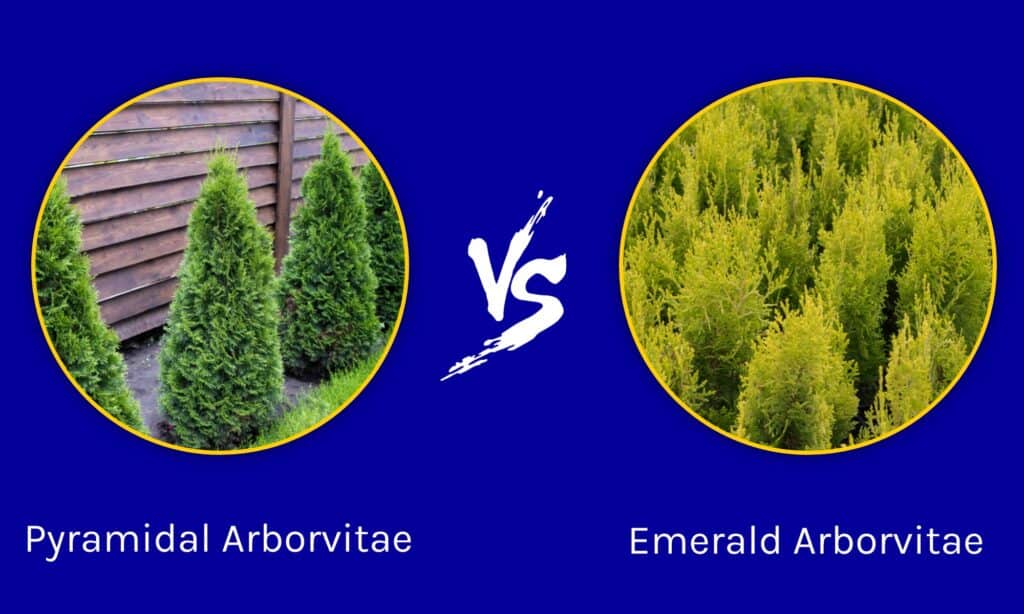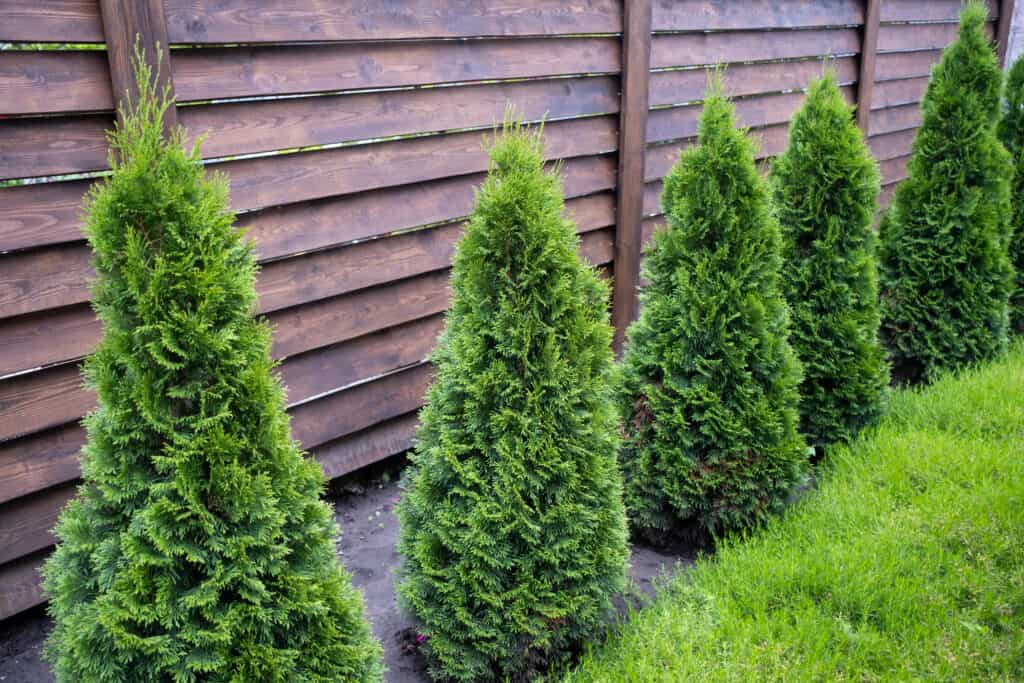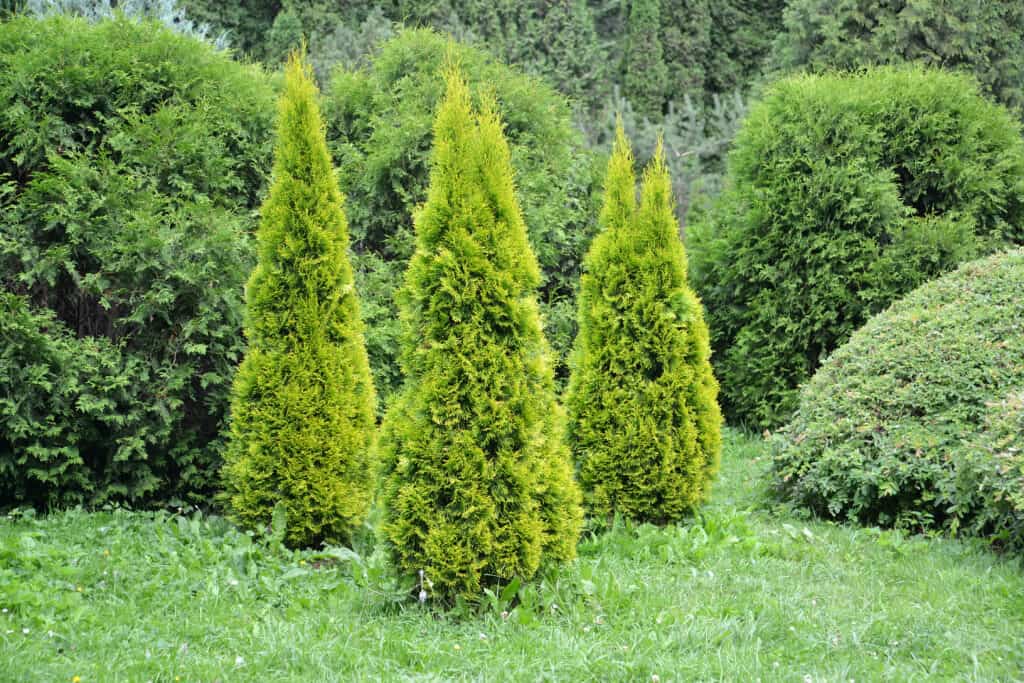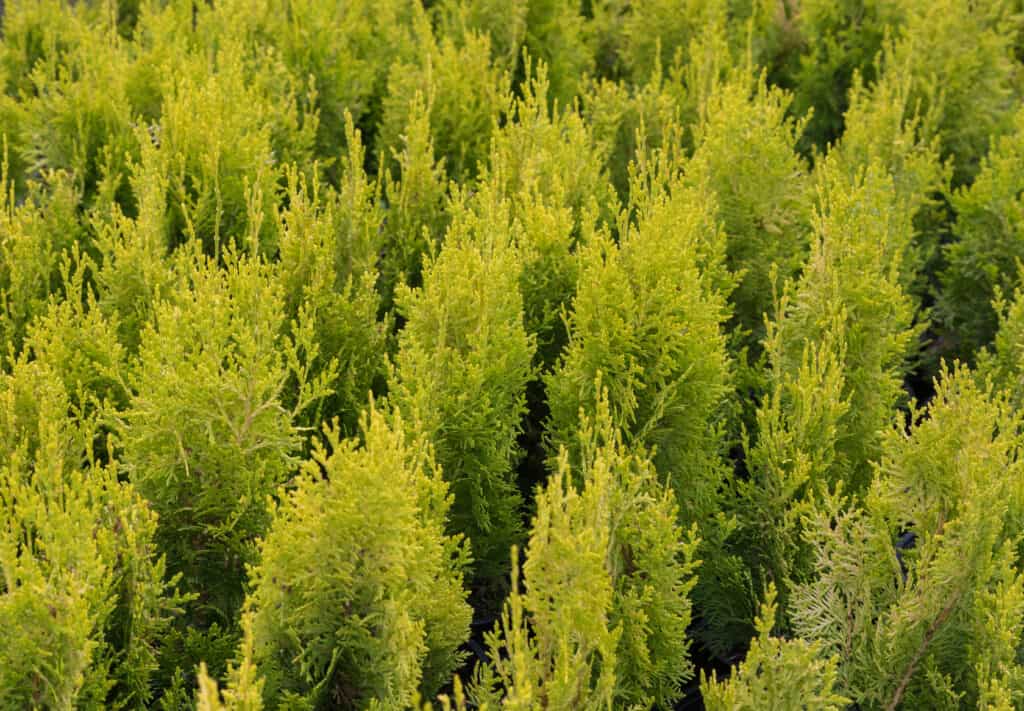You may be wondering, what’s the difference between pyramidal arborvitae and emerald green arborvitae? Both plants are evergreen trees popular for privacy hedges or landscaping. Pyramidal arborvitae and emerald green are also members of the same genus, Thuja, of coniferous trees. Another similarity is that both are cultivars of the arborvitae species.
However, several key distinctions between the two set them apart. Find out some of the main ways they differ from each other in this comprehensive, debate-ending article. Hopefully, by the end, you’ll know which is better for your garden!
Comparing Pyramidal Arborvitae vs. Emerald Arborvitae

| Pyramidal Arborvitae | Emerald Green | |
|---|---|---|
| Botanical Name | Thuja occidentalis ‘Pyramidalis’ | Thuja occidentalis ‘Emerald Green’ or Thuja occidentalis ‘Smaragd’ |
| Other Names | Eastern White Cedar Eastern Arborvitae American Arborvitae | Smaragd arborvitae American arborvitae Emerald green arborvitae |
| Description | – Narrowly upright, columnar/ pyramidal shaped – Bright green to dense deep green foliage, scale-like sprays of foliage, soft-textured, less refined – Multi-stemmed, shallow root system | – Narrow, needled, pyramidal shape – Soft, bright green, scale-shape foliage arranged in vertical fanlike sprays – Multi-stemmed, fibrous shallow root system |
| Height and Spread | Mature height: 12 – 25 ft high Mature spread: 3 – 6 ft wide Growth rate: 1 – 2 ft per year | Mature height: 12 – 15 ft high Mature spread: 3 – 4 ft wide Growth rate: 1 – 2 ft per year until it matures |
| Growing and Adaptation | – Slow to medium-growing plant – USDA Hardiness zones 3 – 8 – Full sun to partial shade – Soil type: average to moist – Soil pH: Average to slightly acidic | – Slow-growing to medium-growing plant, low-maintenance – USDA Hardiness zones 2 – 8 – Full or partial sun – Soil type: loamy, moist but well-drained soil – Soil pH: neutral to alkaline |
The Key Differences Between Pyramidal Arborvitae and Emerald Green
The differences between pyramidal arborvitae and emerald green are most noticeable in their overall shape, size, and foliage color. However, the two trees are similar and can be easily confused if tiny details aren’t considered. Below you’ll find a detailed overview outlining the key differences between the two. Keep reading to learn more!
Pyramidal Arborvitae vs. Emerald Green: Cultivars

The pyramidal arborvitae cultivar is scientifically called
Thuja occidentalis’ Pyramidalis.’©vfhnb12/Shutterstock.com
Although the pyramidal arborvitae and the emerald green belong to the same botanical family, genus, and species, they are two distinct cultivars of Thuja Occidentalis. The pyramidal arborvitae cultivar is scientifically called Thuja occidentalis ‘Pyramidalis,’ while the emerald green scientific name is Thuja occidentalis ‘Smaragd.’
Pyramidal Arborvitae vs. Emerald Green: Appearance

Pyramidal arborvitae trees have fragrant, dense green, and soft-textured foliage.
©Irina Borsuchenko/Shutterstock.com
The appearance of these arborvitae trees is one of the easiest ways to tell them apart. As the name implies, the pyramidal arborvitae is a pyramid-shaped evergreen tree with a mature height of 12 – 25 ft and a mature spread of 3 – 6 ft. On the other hand, the emerald green is a shorter, more compact version of the pyramidal arborvitae. It grows only 12 – 15 ft tall and spreads 3 – 4 ft wide.
If you were to take a closer look at a pyramidal and an emerald green arborvitae, you’d notice they both have scale-like sprays of foliage. However, pyramidal arborvitae trees have fragrant, dense green, and soft-textured foliage. Emerald green trees have bright-emerald green foliage. Another visual difference in the foliage is that pyramidal arborvitae scale-like sprays of foliage turn yellowish-brownish during winter, while emerald green foliage turns green-yellow during fall.
Pyramidal Arborvitae vs. Emerald Green: Growth Rate

Emerald green
trees grow fast
, about 1-2 ft per year when young.
©Deyana Stefanova Robova/Shutterstock.com
Though both trees are considered slow-growing plants, the maturity growth rate of the pyramidal arborvitae is much faster than that of emerald green. While both trees’ growth rate is 1 – 2 ft per, emerald green’s growth rate slows down once established. That is, emerald green trees grow fast, about 1-2 ft per year when young. They then grow about 0.5 – 1 ft per year once established until they reach a maximum height of 12-15 ft.
Pyramidal Arborvitae vs. Emerald Green: Growth Preferences
Another difference between these two arborvitaes is their growth preferences and adaptation levels. This means that the two plants have different ideal growing conditions.
They both grow in a range of lighting conditions, from full sun to partial shade, and thrive on average in moist soil types. They are also adaptable to moist, well-drained soil that is either acidic or alkaline.
However, pyramidal arborvitae is susceptible to winter burn and requires regular watering, especially during the summer. Conversely, its counterpart is more heat and drought-tolerant. Given these two arborvitae plants’ sunlight and soil preferences, we can conclude that the pyramidal arborvitae is a low to average maintenance tree. On the other hand, emerald green is a low-maintenance plant.
These two cultivars are considered winter-hardy. Pyramidal arborvitae trees best grow in USDA zones 3 to 8. In contrast, emerald green arborvitae plants thrive in USDA growing zones 2 to 8.
Pyramidal vs. Emerald Green: Which Is Best for Your Garden?
Both trees are excellent choices for a privacy hedge or a windbreak. They are ideal for landscaping, adding to your home’s curb appeal, and creating an inviting entryway.
The best way to decide which one’s best for your garden is to consider what kind of tree you want. If you want that tree to be a little more tolerant of different climates, then the emerald green is the best. But if you’re looking for a taller tree that provides more privacy, then the pyramidal arborvitae will be the better tree.
Up Next:
- American Arborvitae vs. Emerald Green: What’s the Difference?
- Emerald Green Arborvitae vs. Green Giant: What Are the Differences?
- Degroot’s Spire vs. Emerald Green Arborvitae
The photo featured at the top of this post is © AKM Creatives/Shutterstock.com
Sources
- Embrace Gardening, Available here: https://www.embracegardening.com/different-types-of-arborvitae-tree-varieties/
- Chicago Botanic Garden, Available here: https://www.chicagobotanic.org/plantcollections/plantfinder/thuja_occidentalis_pyramidalis--pyramidal_american_arborvitae
- WindbreakTrees.com, Available here: https://www.windbreaktrees.com/pyramidal-arborvitae
- PlantSnap, Available here: https://www.plantsnap.com/plantblog/arborvitae-types/
Thank you for reading! Have some feedback for us? Contact the AZ Animals editorial team.






